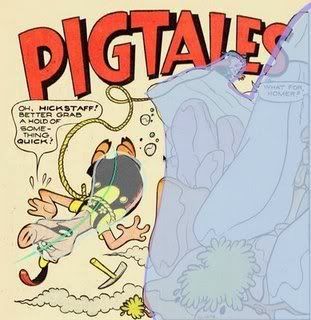Once again, I'll let the tireless John K do my blogging for me:
JohnK Archives
Ran across this in a completely unrelated search looking for facts and info on the Ether Bunny after my buddy Prammaven just posted his newly completed film about him. Seemed like a weird coincidence, and I don't know why all these particular posts are lumped together on one page, but there's a lot of good stuff there, much of it about writing and story for cartoons. And of course, you can find more by clicking on the tags at the bottom of any post.
I feel like my quest for Poetic Form is at an end, at least for the time being. I have a handle on what it is... at least the particular strain of poetic form described in Martin Esslin's book Theatre of the Absurd. And the main point of that whole quest was to free myself from the restrictions of Narrative Form that have been hammered into my head all my life by Hollywood. Until discovering the nature of Poetic Form (as described in the About Me box on the right... convenient place for it right here at the top o the old blog, where I'll see it again and again and try to get it hammered in instead) I couldn't imagine any way to make a short stopmotion film other than by telling a story. The funny thing is, I've seen lots of short films that don't follow Narrative Form at all and that work brilliantly! Many of them don't follow what I understand as Poetic Form either.
Of course you have simple short gag films, where the joke is the thing. But somewhere in that long and rambling list of blog posts I linked to above, John K discusses a different approach. He has always maintained that a cartoon is, first and foremost, funny drawings. And that, essentially, all they really have to do is keep the audience entertained. He did a post on structure that I like, which is pretty freeing. If I can absorb that into my head (it seems to take a while for things to really soak in there, but once they do they're in for good) then I should be able to just start making films without worrying too much about structure and form.
Also, he stresses the importance of learning the basics of animation and drawing before trying to create full films. This confirms my long-held belief that the way to learn stopmotion is by making a couple of puppets, and doing a lot of shots with them. Just little single-take episodes, working out how to make them move in interesting ways, how to use space, and incidentals like lighting, staging etc. I think a lot of these will get you most of your basics, even if you don't know the names of the principles you're learning. Then you start linking a series of shots together creating scenes. After that, it's just a matter of figuring out how to start and finish a film.
This is the approach I was using, until I got caught up in the StopMoShorts thing and the emphasis was on making finished films right from the start. And then I got myself into this Radke project, which is a massively huge undertaking in terms of fabrication before I can even start animating. I'm bogged down on it completely, hit the wall, stuck in a rut, uninspired. Burnt out being the technical term. Tooo many puppets, too many bottles, tiny little labels etc. Makes my brain hurt thinking about it!
And suddenly here's Monster Month upon us!!! Jeffrey is launching himself into it, and Sven might be contributing as well. I think it's time to put this bar flick on hold and do something creative and fun for a little while.
Showing posts with label John K. Show all posts
Showing posts with label John K. Show all posts
Thursday, October 02, 2008
Wednesday, September 03, 2008
John K - not a fan of his work, but he's a great teacher

Recently I've been edumacatin' myself about traditional cartooning concerns via John K's Stuff blog:
Label=COMPOSITION
John K(ricfalusi) is the creator of Ren & Stimpy and other sick & twisted type cartoons. Not my cup of tea, but he's using his blog to educate a new generation of aspiring cartoonists from which he hopes tp recruit a stable of employees - and for that he uses examples from great cartoons of the past, both still and animated. And he reveals a vast wealth of knowledge about it. Pretty smart feller, he is!
The link is for all his posts about composition, which are the ones I've been absorbing. Exciting stuff for sure, and it makes me almost want to give up stopmo and turn to cartooning, which is the purest form of animation. Most of these principles can be applied only loosely to stopmo (unless you were to design a new set for each shot, or work out some way to substitute new elements each time you move the camera). There's a lot more latitude in drawing... you're not bound by reality as much as when you have to make things in 3 dimensions. But just being aware of these design principles can help you lay out your sets and work out a style for everything. It can also help you break out of boring visual styles (or lack of style).
In related news, I have finally managed to get a printer/scanner that actually works with my computer, so work on my film will be able to resume.
Subscribe to:
Posts (Atom)
